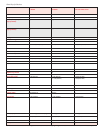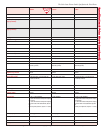
The Color Laser Printer Guide: A–Z Guide to Features and Technology
Entire Contents © 2006 Progressive Business Publications. Copying of Pages Prohibited.To Order: 800 247 2185 or www.betterbuys.com 69
dots. The more dots, the higher the resolution and gener-
ally the better the image quality. The number of vertical
lines by the number of horizontal lines in a square inch
defines r
esolution. So w
hen you see a quoted resolution
of, say, 200 x 400dpi (dots per inch), it means 200 verti-
cal lines crossing 400 horizontal lines in each square inch
— or 80,000 dots per squar
e inch.
See Dots per inc
h.
Retail channel: Refers to retail stores such as Office
Depot, OfficeMax, and Staples that sell low-end office
equipment. Also includes mail-order companies, ware-
house stores, and consumer electr
onics stores.
RIP: Raster image processor. See Controller.
Toner saver mode: Feature in some printers that allows
you to print some pages with fewer toner particles (less
density),
saving money. This is useful for in-house draft
documents. A few models allow you to select this mode
right on the printer b
y pr
essing a b
utton.
USB: Uni
v
er
sal Serial Bus, a technology for connecting
computers to peripheral devices such as printers. USB
offers several advantages over parallel connectivity. It
transmits data much faster, and the technology enables
you to “plug and play.” USB technology is supported by
both PCs and Macs
.
A g
r
owing number of printers have
USB connectivity only. Ethernet servers usually are
a
ttached to the USB port. All units in this guide use
Version 2.0 of the USB standard, which allows for faster
operation.
See also Parallel port.
W
i-Fi:
See W
ir
eless Ether
net.
W
indows printing:
See GDI.
Wireless Ethernet: Also called Wi-Fi or IEEE 802.11b
or g. This is a growing standard for wireless local area
networks (WLANs). This protocol defines a full Ethernet
connection between devices and gives physically uncon-
n
ected computers connectivity to a printer over a local
area network (LAN). IEEE 802.11b signals can go
through walls, and transmissions can extend to a distance
of 100 feet or more. 802.11g is a faster version than
802.11b, though all 802.11g devices can support 802.11b.
A wireless option is available for the Samsung CLP-600N,
which also has standard Ethernet and USB connectivity.


















